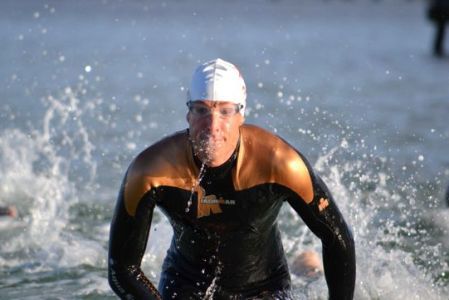Triathlon is a sum of three component parts. The swim leg, generally speaking, comprises the least of the 3 time components that make up the sport. A swim leg can range from the 750 metres of a sprint distance race, to the 3.8 km Ironman event. Many variables come into play in a Triathlon swim leg; water temperature, body of water (seawater/ocean, lake, river), and conditions (smooth, choppy, current affected etc).

The majority of triathletes are professional people with a generous amount of disposable income to spend on their chosen pursuit, However, time is a restrictor; so the average punter has to decide how best to train with the small windows they have in any 24 hour period. Swimming training is often viewed as a necessary evil that is squeezed in between the regular, structured bike and run sessions.
So, is swimming training that important for triathletes given the perennial balancing act of life and the program?
I would argue, that an effective, regular year-round swimming program is critical for every triathlete’s success
- The overall benefits of regular swimming training
Injury prevention and management is key for triathletes executing significant volumes of high impact exercise. Swimming is a pursuit that can be done at a high intensity almost daily. Ideally, swimming 2 to 3 squad sessions a week of 4-6 kms, plus an ocean swim, will develop a strong aerobic capacity that carries over to the other Triathlon disciplines. Swimming also has a therapeutic effect on the muscular system. It can unwind the built up muscle tension that accrues in the day to day struggles of training, work and life.
- A strong swim leg provides and exponential improvement to the bike and run legs
Generally, a triathlete who exits the water in the lead, or with the first pack, will be ideally placed on the road to begin the bike segment with athletes at the performance end of the race spectrum. Swimmers coming out minutes behind find themselves having to chase the leaders and being surrounded by bike riders who will not have the same level of riding ability as those athletes already up the road. The various swim leg distances in Triathlon have their own nuances that should be addressed.
The Sprint and Olympic Distance triathlons (750 metre and 1500 metre swim respectively) have a sense of urgency about them that is not really there in the longer Ironman and 70.3 events. In this case, the swim leg can mean the difference between winning or losing. Coming out of the water a minute plus down on the leader is very difficult to make up due to the relative distances of the bike/run.
In the ITU World Series events held each year. The winner of the race will come from the first 5 to 10 out of the water. A good example is the World Series Grand Final recently held in Beijing, China. In the men’s event a break of 30 seconds onto the road could not be breached by the second bike pack - and blew out to 2 minutes + by the finish line.
The 70.3 and Ironman distance (1.9 and 3.8km respectively) are longer swim legs but no less crucial in overall performance. In the 2009 Ironman triathlon held in Kona, Hawaii. One of the favourites, Chris McCormack, found himself 1 minute 50 seconds behind the favourites exiting the water. He knew he had only one choice; to ride hard and catch his main rivals. It took Macca 80 miles before he caught the leaders; while they were in a steady state zone, fuelling and staying relaxed. By that stage he was cramping and depleted. Chris managed to run ok for a while but his “catch up” effort took its toll and he was forced to walk portions of the run. In hindsight, he declared that a “bad” swim had cost him a potential world championship. He did not make the same mistake the following year in 2010 where he came out of the water with the leaders and went on to win his 2nd Ironman world title.
So, is swimming training as important as cycling and running training for overall performance in a Triathlon? The short answer is YES! Swimming can add value to your overall aerobic fitness, and enable more effective recovery from running and cycling training. In addition, being a strong swimmer can set up a superior triathlon race; in terms of position on the road and a more controlled, energy apportioned overall performance.
Next time you sit down and begin to plan your training program, solo or with a coach, reflect upon how much respect you have given your swimming training, and make the necessary adjustments. You might be surprised at the results…







